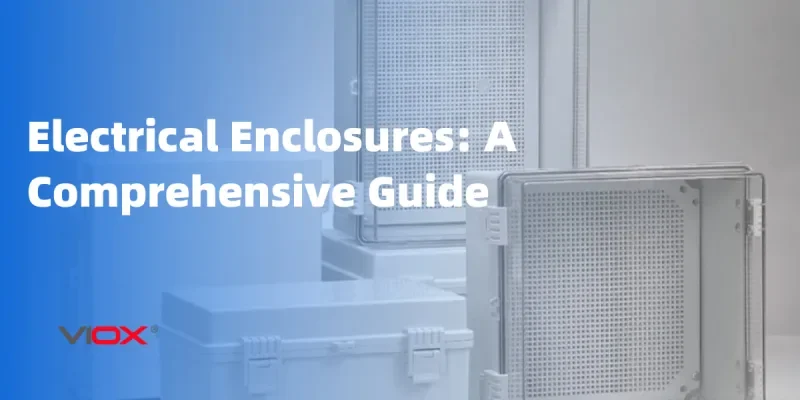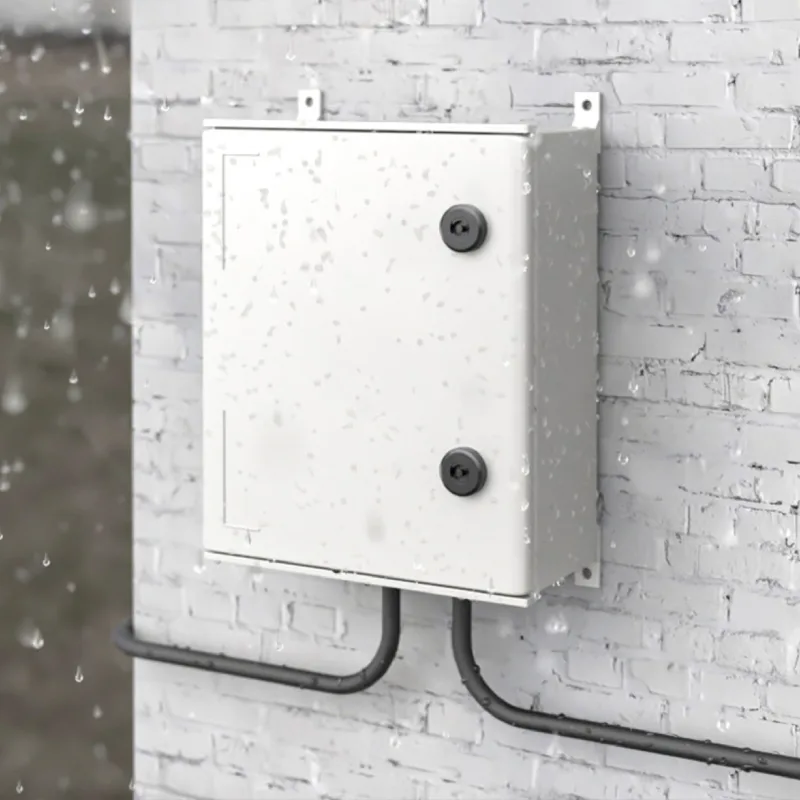Elektrická skříň je ochranný kryt, který chrání elektrické komponenty před vlivy prostředí, neoprávněným přístupem a fyzickým poškozením a zároveň zajišťuje soulad s předpisy a provozní bezpečnost. Výběr správné skříně zabraňuje selhání zařízení, snižuje riziko požáru a splňuje požadavky NEC (Národní elektrotechnický předpis), které upravují elektrické instalace v obytných, komerčních a průmyslových aplikacích.
Co je to elektrická skříň?
Elektrická skříň je vyrobená skříň nebo rozvaděč určený k uložení a ochraně elektrického zařízení, jako jsou jističe, spínače, transformátory a ovládací panely. Tyto ochranné kryty plní tři kritické funkce: ochranu před vlivy prostředí, dodržování bezpečnostních předpisů a provozní přístupnost.
Klíčové komponenty elektrických skříní:
- Materiál pouzdra: Ocelová, nerezová ocelová, hliníková, sklolaminátová nebo plastová konstrukce
- Těsnicí systém: Těsnění, těsnicí pásky nebo svařované spoje pro ochranu před vlivy prostředí
- Přístupové prvky: Výklopné dveře, odnímatelné kryty nebo západkové mechanismy
- Možnosti montáže: Montáž na stěnu, podlahu nebo sloup
- Vnitřní součásti: DIN lišty, zemnicí lišty, a systémy pro montáž komponent
Typy elektrických skříní: Kompletní srovnání

Klasifikace stupňů krytí NEMA
| Stupeň krytí NEMA | Úroveň ochrany | Typické aplikace | Vnitřní/Venkovní | Klíčové vlastnosti |
|---|---|---|---|---|
| NEMA 1 | Pro všeobecné použití | Vnitřní suché prostory | Vnitřní | Základní ochrana před náhodným dotykem |
| NEMA 3R | Odolnost proti povětrnostním vlivům | Venkovní instalace | Venkovní | Ochrana proti dešti, plískanicím, sněhu s odvodňovacími otvory |
| NEMA 4 | Vodotěsné | Omyvatelné prostory, pobřežní oblasti | Obojí | Kompletní ochrana proti vodě, těsnění |
| NEMA 4X | Odolné proti korozi | Chemické závody, námořní prostředí | Obojí | Nerezová ocel/sklolaminát, chemická odolnost |
| NEMA 12 | Průmyslové | Výrobní haly | Vnitřní | Ochrana proti prachu, oleji, chladicí kapalině |
| NEMA 6P | Ponorné | Podzemní instalace | Obojí | Ochrana proti dočasnému ponoření |
Srovnávací tabulka materiálů
| Materiál | Náklady | Odolnost | Odolnost proti korozi | Hmotnost | Nejlepší aplikace |
|---|---|---|---|---|---|
| Uhlíková ocel | Nízká | Vysoká | Špatná (vyžaduje nátěr) | Těžké | Vnitřní, suché prostředí |
| Nerezová ocel | Vysoká | Velmi vysoká | Vynikající | Těžké | Chemické, námořní, potravinářské zpracování |
| Hliník | Střední | Vysoká | Dobrý | Lehký | Venkovní aplikace citlivé na hmotnost |
| Sklolaminát | Střední-Vysoká | Vysoká | Vynikající | Lehký | Korozivní prostředí, pobřežní oblasti |
| Polykarbonát | Nízká až střední | Střední | Dobrý | Velmi lehký | Nemetalické požadavky, RF transparentnost |
Pochopení stupňů krytí NEMA vs. IP
NEMA (Národní asociace výrobců elektrických zařízení) hodnocení jsou severoamerické normy, které specifikují úrovně ochrany skříně, zatímco Stupeň krytí IP (ochrana proti vniknutí) jsou mezinárodní normy používané globálně.
Referenční převod NEMA na IP
| Stupeň krytí NEMA | Ekvivalentní stupeň krytí IP | Popis ochrany |
|---|---|---|
| NEMA 1 | IP10 | Ochrana před objekty >50 mm |
| NEMA 3R | IP24 | Ochrana před deštěm a objekty >12 mm |
| NEMA 4 | IP65 | Prachotěsné a ochrana proti vodním paprskům |
| NEMA 4X | IP65 | Prachotěsné, ochrana proti vodním paprskům, odolné proti korozi |
| NEMA 12 | IP54 | Omezená ochrana proti prachu a stříkající vodě |
| NEMA 6P | IP67 | Prachotěsné a dočasné ponoření |
🔍 Tip odborníka: Stupně krytí NEMA zahrnují další výkonnostní kritéria nad rámec stupňů krytí IP, jako je odolnost proti korozi, konstrukční požadavky a testovací normy specifické pro severoamerické podmínky.
Klíčové aplikace a případy použití
Rezidenční aplikace
- Hlavní elektrické panely: NEMA 1 nebo 3R v závislosti na umístění
- Patice měřidel: NEMA 3R pro venkovní instalaci
- Vybavení bazénu: NEMA 4X pro odolnost vůči chlóru
- Venkovní zásuvky: NEMA 3R vodotěsné boxy
Komerční aplikace
- Ovládání HVAC: NEMA 1 pro vnitřní použití, NEMA 4 pro střešní jednotky
- Ovládání osvětlení: NEMA 1 pro kancelářské budovy
- Bezpečnostní systémy: NEMA 4 pro venkovní kamery a řízení přístupu
- Panely požárního poplachu: NEMA 1 se specifickými certifikacemi UL
Průmyslové aplikace
- Řídicí centra motorů: NEMA 12 pro výrobní prostředí
- Řízení procesů: NEMA 4X pro chemické zpracování
- Instrumentace: NEMA 4 pro měření a monitorování
- Distribuce energie: NEMA 3R pro venkovní rozvodny
Jak vybrat správný elektrický rozvaděč
Krok 1: Posouzení podmínek prostředí
- Umístění: Požadavky na vnitřní vs. venkovní instalaci
- Vystavení vlhkosti: Déšť, oplachování, úrovně vlhkosti
- Teplotní rozsah: Limity provozní a skladovací teploty
- Expozice chemickým látkám: Přítomnost korozivních látek
- Fyzická nebezpečí: Dopad, vibrace nebo bezpečnostní obavy
Krok 2: Určení požadavků na velikost
- Inventář komponent: Seznam veškerého zařízení, které má být umístěno
- Odvod tepla: Výpočet tepelné zátěže a potřeby ventilace
- Požadavky na přístup: Servisní prostory a pracovní prostor
- Budoucí rozšíření: Ponechte 25% dodatečného prostoru pro úpravy
- Dodržování předpisů: Splňte požadavky NEC článek 110.26 na pracovní prostor
Krok 3: Kritéria pro výběr materiálu
Vyberte nerezovou ocel, když:
- Je přítomna chemická expozice
- Mořské nebo pobřežní prostředí
- Aplikace pro zpracování potravin
- Dlouhodobá odolnost proti korozi je kritická
Vyberte hliník, když:
- Snížení hmotnosti je důležité
- Je potřeba dobrá odolnost proti korozi
- Nákladová efektivita je prioritou
- Venkovní aplikace bez extrémních chemikálií
Vyberte uhlíkovou ocel, když:
- Vnitřní, kontrolované prostředí
- Existují rozpočtová omezení
- Je vyžadována vysoká mechanická pevnost
- Lze udržovat správný nátěr
Krok 4: Ověření souladu s předpisy
- NEC článek 312: Skříně, pojistkové skříně a patice měřidel
- NEC článek 314: Zásuvky, zařízení, tahové a spojovací krabice
- Místní dodatky: Zkontrolujte obecní elektrické předpisy
- UL Seznamy: Zajistěte odpovídající certifikaci pro danou aplikaci
⚠️ Bezpečnostní upozornění: Před dokončením výběru rozvaděče se vždy poraďte s místními elektrotechnickými předpisy a orgány s jurisdikcí (AHJ). Instalace, které nejsou v souladu s předpisy, mohou vést k bezpečnostním rizikům a neúspěšným kontrolám.
Osvědčené postupy při instalaci
Plánování před instalací
- Průzkum lokality: Ověřte montážní povrch a přístupnost
- Trasy potrubí: Naplánujte vstupní body a správu kabelů
- Požadavky na uzemnění: Zajistěte řádné uzemňovací prvky
- Ověření vzdáleností: Zkontrolujte pracovní prostor podle NEC 110.26
Proces instalace
- Příprava montáže: Vyrovnejte a zajistěte montážní povrch
- Umístění skříně: Použijte vhodné upevňovací prvky pro daný podklad
- Připojení trubek: Nainstalujte správné tvarovky a těsnění
- Instalace uzemnění: Připojte zemnicí vodič zařízení
- Instalace komponent: Namontujte zařízení s dostatečnými rozestupy
- Závěrečné testování: Ověřte připojení a ochranné systémy
Nejčastější chyby při instalaci, kterých je třeba se vyvarovat
- Nedostatečné utěsnění: Ohrožuje ochranu dle NEMA
- Nesprávné uzemnění: Vytváří bezpečnostní rizika a porušuje předpisy
- Přeplnění: Snižuje odvod tepla a přístupnost
- Nesprávné trubkové tvarovky: Umožňuje vniknutí vlhkosti a nečistot
- Nedostatečné vzdálenosti: Porušuje požadavky NEC na pracovní prostor
Odstraňování běžných problémů se skříněmi
Problémy s vnikáním vlhkosti
Příznaky: Kondenzace, koroze, selhání zařízení
Řešení:
- Zkontrolujte stav těsnění a správné stlačení
- Zkontrolujte odtokové otvory, zda nejsou ucpané (skříně NEMA 3R)
- Nainstalujte ohřívače nebo ventilaci pro regulaci teploty
- V případě potřeby upgradujte na vyšší stupeň krytí NEMA
Problémy s přehřátím
Příznaky: Selhání zařízení, zkrácená životnost komponent
Řešení:
- Přidejte ventilační ventilátory nebo žaluzie
- Zvětšete velikost skříně pro lepší odvod tepla
- Nainstalujte výměníky tepla pro extrémní podmínky
- Přemístěte komponenty generující teplo
Problémy s korozí
Příznaky: Povrchová rez, degradace materiálu
Řešení:
- Upgradujte na nerezovou ocel nebo hliník
- Naneste ochranné povlaky na uhlíkovou ocel
- Zlepšete ventilaci pro snížení vlhkosti
- Zvažte katodickou ochranu pro podzemní aplikace
Rozhodovací matice pro výběr
Průvodce rychlým výběrem
| Typ Aplikace | Životní prostředí | Doporučené NEMA | Volba materiálu | Zvláštní aspekty |
|---|---|---|---|---|
| Domácí rozvaděč | Vnitřní | NEMA 1 | Uhlíková ocel | UL Listed, správná velikost |
| Venkovní odpojovač | Vnější stěna | NEMA 3R | Hliník/Ocel | Povrchová úprava odolná proti UV záření |
| Vybavení bazénu | Vlhké prostředí | NEMA 4X | Nerezová ocel | Odolnost proti chlóru |
| Průmyslové řízení | Tovární hala | NEMA 12 | Uhlíková ocel | Ochrana proti oleji/chladicí kapalině |
| Chemický proces | Korozivní prostředí | NEMA 4X | Nerezová ocel/Sklolaminát | Chemická kompatibilita |
| Ponorné čerpadlo | Pod úrovní terénu | NEMA 6P | Nerezová ocel | Hodnocení pro dočasné ponoření |
🔧 Odborné doporučení: Pokud si nejste jisti mezi dvěma stupni krytí NEMA, zvolte vyšší úroveň ochrany. Dodatečné náklady jsou obvykle minimální ve srovnání s potenciálními náklady na výměnu zařízení a prostoje.
Soulad s předpisy a certifikace
Požadavky národního elektrotechnického předpisu (NEC)
- Článek 110.3(B): Zařízení musí být uvedeno a označeno
- Článek 312: Specifické požadavky na rozvaděče a výřezové skříně
- Článek 314: Předpisy pro spojovací krabice a tělesa trubek
- Článek 110.26: Pracovní prostor kolem elektrického zařízení
Požadované certifikace
- Certifikováno UL: Bezpečnostní certifikace Underwriters Laboratories
- Certifikace CSA: Kanadská asociace pro normalizaci (pokud je relevantní)
- NRTL: Schválení národně uznávané zkušební laboratoře
- Místní schválení: Požadavky specifické pro danou obec
Aspekty inspekce
- Ověřte, zda hodnota krytí odpovídá požadavkům aplikace
- Potvrďte správnou instalaci a uzemnění
- Zkontrolujte volné pracovní prostory
- Ověřte uspořádání a označení komponent
Pokročilé funkce a možnosti
Systémy klimatizace
- Ohřívače: Zabraňte kondenzaci v chladném prostředí
- Ventilátory: Zajistěte cirkulaci vzduchu pro odvod tepla
- Klimatizace: Přesné chlazení pro citlivou elektroniku
- Odvlhčovače: Regulujte vlhkost ve vlhkých podmínkách
Zabezpečení
- Uzamykací mechanismy: Zámky na klíč, kombinační zámky, elektronický přístup
- Pečetě proti neoprávněné manipulaci: Detekujte neoprávněný přístup
- Pozorovací okénka: Umožňují sledování stavu bez otevírání
- Poplašné systémy: Vzdálené monitorování polohy dveří
Funkce přístupnosti
- Odnímatelné panely: Snadný přístup ke komponentám
- Dveře na pantech: Více možností otevírání
- Západky bez použití nářadí: Rychlý přístup pro údržbu
- Vyjímatelné komponenty: Zjednodušené servisní postupy
Často Kladené Otázky
Jaký je rozdíl mezi kryty odolnými proti povětrnostním vlivům a vodotěsnými kryty?
Kryty odolné proti povětrnostním vlivům (NEMA 3R) chrání před deštěm, plískanicemi a sněhem, ale umožňují řízený odvod vody otvory pro odvod vody. Vodotěsné kryty (NEMA 4) poskytují kompletní ochranu proti vniknutí vody pomocí těsnění a jsou vhodné pro přímé vystavení vodě, jako jsou aplikace s oplachováním.
Mohu upravit stávající kryt, abych dosáhl vyššího hodnocení NEMA?
Obecně ne. Hodnocení NEMA jsou stanovena komplexním testováním kompletního systému krytu. Polní úpravy obvykle ruší hodnocení a seznam UL. Je nákladově efektivnější nahradit krytem s odpovídajícím hodnocením.
Jak vypočítám požadovanou velikost krytu?
Vypočítejte na základě rozměrů komponent plus 25% prostoru pro rozšíření, minimálních poloměrů ohybu vodičů podle NEC 312.6 a požadavků na pracovní prostor. Zahrňte tepelné aspekty pro zařízení generující teplo a zajistěte dostatečné větrání.
Jaké požadavky na uzemnění platí pro elektrické kryty?
Podle NEC 250.86 musí být kovové kryty připojeny k zemnícímu vodiči zařízení. Nekovové kryty vyžadují uzemnění pouze v případě, že obsahují kovové komponenty, které by se mohly dostat pod napětí.
Jak často by se měla kontrolovat těsnění krytu?
Roční prohlídky se doporučuje pro kritické aplikace. Zkontrolujte stav těsnění, kompresi a veškeré známky vniknutí vlhkosti. Vyměňte těsnění, pokud jsou prasklá, stlačená nebo vykazují známky poškození.
Mohou být v jednom krytu smíchány komponenty s různým hodnocením NEMA?
Celková úroveň ochrany krytu je omezena komponentou s nejnižším hodnocením. Všechny průchody, armatury a příslušenství musí zachovat hodnocení NEMA krytu, aby byla zachována integrita ochrany.
Jaká je typická životnost elektrického krytu?
Kryty z uhlíkové oceli: 15-25 let při správné údržbě
Hliníkové skříně: 20-30 let ve vhodném prostředí
Nerezové ocelové skříně: 25-40 let s minimální údržbou
Skříně ze sklolaminátu: 20-35 let v závislosti na UV záření
Existují omezení velikosti pro různá hodnocení NEMA?
Ačkoli normy NEMA nestanovují limity velikosti, větší skříně čelí větším výzvám při udržování hodnocení kvůli tepelné roztažnosti, stlačení těsnění a strukturálním požadavkům. Zakázkové skříně mohou vyžadovat speciální inženýrství a testování.
Doporučení pro profesionální instalaci
Kdy si najmout profesionála:
- Instalace vyžadující elektrická povolení
- Vysokonapěťové aplikace (nad 600 V)
- Instalace v nebezpečných prostorách
- Složité požadavky na uzemnění nebo pospojování
- Úpravy skříní na zakázku
Aplikace vhodné pro kutily:
- Jednoduchá výměna stávajících skříní
- Nízkonapěťové řídicí instalace
- Základní vylepšení bytových rozvaděčů
- Běžná údržba a kontroly
🏆 Odborný pohled: Výběr a instalace elektrické skříně přímo ovlivňuje spolehlivost systému, bezpečnost a soulad s předpisy. Investice do správné specifikace skříně zabraňuje nákladným poruchám zařízení a zajišťuje dlouhodobý provozní úspěch.
Související
Výrobce skříně rozbočovací skříně




